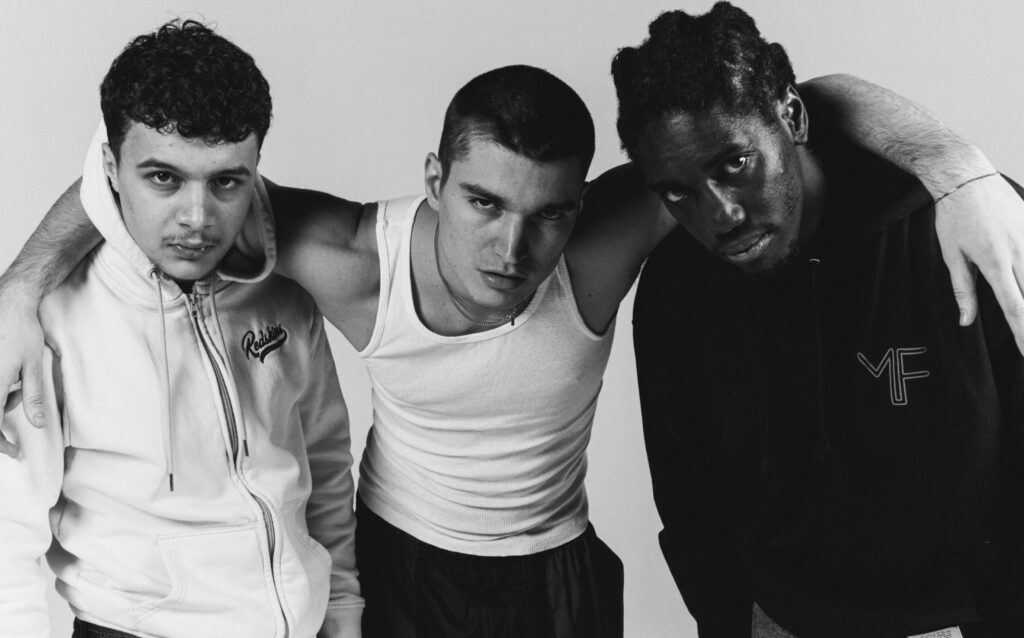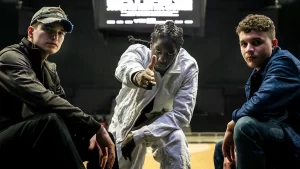La Haine: A Timeless Reflection on France’s Social Struggles
4 min read
Actor Samy Belkessa (Said), Alexander Ferrario (Vinz) and rapper and actor Alivor (Hubert).

Actor Samy Belkessa (Said), Alexander Ferrario (Vinz) and rapper and actor Alivor (Hubert).
As a new hip-hop musical adaptation of the iconic French film La Haine opens in Paris, director Mathieu Kassovitz discusses the social issues that inspired his original work and how they resonate even today.
Just days after Kassovitz announced the musical adaptation of his 1995 film, tragedy struck when 17-year-old Nahel Merzouk was shot by a police officer in Nanterre, a suburb of Paris. This event reignited protests and riots across France, serving as a stark reminder of the real-life killing that inspired La Haine.
In 1993, the death of Makomé M’Bowolé, a 17-year-old Zairian immigrant shot by police while in custody, laid the groundwork for Kassovitz’s film. The narrative of La Haine follows three friends—Hubert, Vinz, and Saïd—over 24 hours after a police beating leaves another youth hospitalized. Their journey through the streets of Paris and Chanteloup-les-Vignes symbolizes the multicultural fabric of France, encapsulated in the phrase “black-blanc-beur” (black-white-Arab), which echoes the colors of the French flag.
Filmed in black and white and influenced by classics like Scarface and Taxi Driver, La Haine provided a rare glimpse into life in the marginalized French suburbs, quickly garnering both critical acclaim and box-office success. Kassovitz, then only 27, won the Best Screenplay award at the Cannes Film Festival. Journalist and filmmaker Rokhaya Diallo notes that it was one of the first major films to spotlight the lives of those in impoverished neighborhoods while confronting the issue of police brutality head-on.
Now, as the film nears its 30th anniversary, the hip-hop musical adaptation, described as an “urban opera,” premieres in Paris before touring throughout France. Featuring about 15 songs from prominent names in the French rap scene, the music is produced by Proof, who has collaborated with artists like electronic duo The Blaze and the Gipsy Kings.
Kassovitz explains that he envisioned the film’s narrative with the dynamism of a musical, which makes this adaptation timely. The film was heavily influenced by hip-hop culture, exemplified by a memorable scene where DJ Cut Killer mixes KRS-One’s “Sound of da Police” with Édith Piaf’s “Non, je ne regrette rien.” Given the ongoing relevance of the film’s themes, Kassovitz feels it deserves a fresh life.

The adaptation comes at a critical time, as discussions around police brutality continue to loom large in French society. After the killing of Nahel, the musical team opted to change the show’s subtitle from “Jusqu’ici tout va bien” (So far, so good) to “Jusqu’ici rien n’a changé” (So far, nothing has changed), reflecting a more somber reality. Producer Farid Benlagha shares that auditions for the musical drew individuals who felt compelled to share their personal experiences related to police violence, revealing the film’s enduring emotional impact.
The issues depicted in La Haine are even more pressing three decades later. The film returns to the forefront as France grapples with rising racism and xenophobia; a recent survey reported alarming increases in antisemitic and anti-Muslim acts. The phrase spoken by Hubert—“La haine attire la haine” (hatred breeds hatred)—resonates strongly amid current events.
While President Emmanuel Macron’s government has taken a rightward turn on issues of security and immigration, the critical topic of police brutality has been largely sidelined in political discourse. Diallo points out that despite documentation of police-related deaths since 1996, no effective policies have emerged to address these tragedies. Kassovitz expresses skepticism about cinema’s capacity to enact change but still holds some faith in political films, even if he believes they aren’t as crucial as before.
Despite the challenges of effecting political change, La Haine holds significant cultural weight. It paved the way for a generation of films exploring the experiences of those from marginalized suburbs, often created by filmmakers with similar backgrounds. Contemporary works like Les Misérables (2019) and Bac Nord (2020) have further examined these issues, with many now providing necessary female perspectives.
Moreover, rap music, which was gaining prominence during the film’s original release, has since become the dominant genre in France. Despite facing pushback from the music industry, artists like Aya Nakamura—who hails from a suburban background—have achieved international recognition. Yet, even she faced racial prejudice and exclusion from major awards until recently.
By placing music at the center of this new adaptation, Kassovitz and his team aim to highlight the genre’s cultural significance while connecting with a broader audience. The director hopes that while audiences enjoy the show, they will remain aware of its deeper societal context. “The fight goes on,” Kassovitz affirms, indicating that the themes of La Haine continue to inspire discussion and reflection in an ever-evolving landscape.